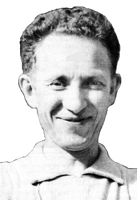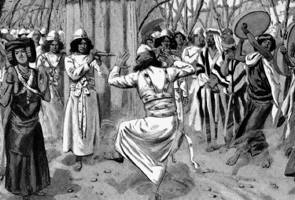
|
Folk Dance Federation of California, South, Inc.
|

|
CLICK AN IMAGE TO ENLARGE
Dancing, in ancient times, played an important part in the daily lives of all people, whether for social needs or solemn religious purposes. This was true even of the ancient Hebrews. The Pentateuch, considered the oldest-written document of the Hebrew Old Testament, mentions dancing.
Miriam, the sister of Moses and Haron, danced rejoicing at the liberation of the Hebrews from Egyptian slavery and at the miracle of the crossing of the sea.
One episode of dancing ended in tragedy for an Israelite maiden in the time of the "Judges." The Tribes were troubled by the Ammonityes, a Trans-Jordanian nation. Jephetah, the Gileadite, of the tribe of Menassah, was chosen to lead a band against them. It was, however, poorly organized and the Ammonites were trained well. Soon, the going was rough and Jephetah vowed that if he were victorious, he would sacrifice the first living thing meeting him upon his return home. Since he was owner of flocks of sheep and cattle, he thought certainly a sheep would be the first thing to meet his eyes. He won the battle, but upon his return, it was not a lamb but his only daughter who geeeted him. She came to welcome her heroic father with a song, danced, and played the tambourine. He was heart broken at the turn of events, but he kept his pledge.
 King David, the Judean, was a noted musician, singer, psalmist, and dancer. Whenever King Saul was depressed, David, then a youth of eighteen, was called to the palace to play sweet music to sooth Saul's nerves. This was the first time musical therapy was ever used.
King David, the Judean, was a noted musician, singer, psalmist, and dancer. Whenever King Saul was depressed, David, then a youth of eighteen, was called to the palace to play sweet music to sooth Saul's nerves. This was the first time musical therapy was ever used.
During the reign of David, the Sacred Arc of the Covenant was recovered from the Philistines and, while it was being carried through the streets of Jerusalem, the King danced in front of it as it was being borne. He must have done some fancy capering, for when he returned home, his wife, Michal, daughter of Saul, lectured him for making a public spectacle of himself. King David was the first to introduce the singing of psalms and use of musical instruments at divine services. Dancing became a part of the services in the Temple.
In Israel (Northern Kingdom) under the reign of Ahab and Jezebel (922-901 BCE) we learn that Jezebel, daughter of a Phoenician King and Priest, erected temples to Phoenician gods. In the temple to Istarte, Jezebel had a great many priests who wore sleevless feminine garb, painted their faces, grew long hair, rolled their hair in the mud, practiced body mutilation, and danced. Some dancing!
When the Judeans were expelled from their southern kingdom, although they hung their lyres upon the willows and wept, pledging themselves to be merry no more, upon their return to Palestine, after 49 years of exile, they brought back many new ideas from the Assyrians and Persians. Pageantry and dancing were introduced to the new Temple which was rebuilt seventy years after the destruction of the first.
During the second night of the feast of Tabernacles (Succoth) the pouring of a libation of water was celebrated. The women's outer court of the Temple was brilliantly lighted. A musical service of praise with dancing and a torchlight parade took place lasting all night. At daybreak, with a blast of trumpets, the priests announced the commencement of the march. The parade led to the spring at Siloah (Shiloh) where water was drawn in a golden ewer. In solemn procession the water was carried back to the Temple where the libation (pouring of the water over the altar) was performed, accompanied by sweet flute music and the strains or melody from countless instruments.
On the fifteenth day of Av (August) the Wood Feast was celebrated in honor of the gathering in the wood which was offered at the altar of the Temple. White-robed maidens gathered among the vine-trees to sing and dance. Judean youth were wont to gather here to select their future wives from among the dancing girls.
Unfortunately, we have no sculptures or paintings depicting the dances of the Hebrews. The prohibition against graven images deprives us of information along these lines. Perhaps the Jewish dances were influenced by the Phoenicians, Idumeans, Philistines, Cannanites, and Egyptians. Certainly the periods of excile and captivity had some effect upon these dances.
Thanks to the Bible, however, we do know that the Hebrews have the oldest dance history, exceeded, perhaps, only by the Hindus, whose pre-historic gods danced. Shiva, the Hindu God of Creation and Destruction, for example, is always presented in a dance pose.
Printed in Let's Dance!, April 1952.